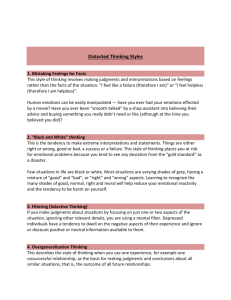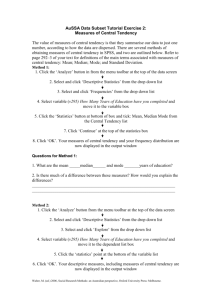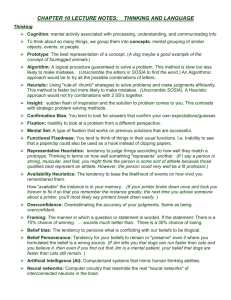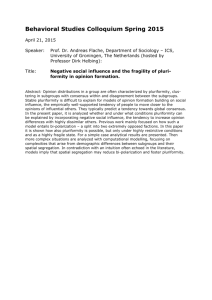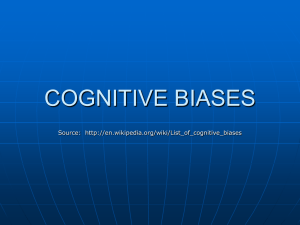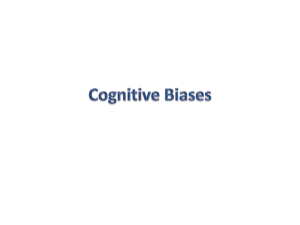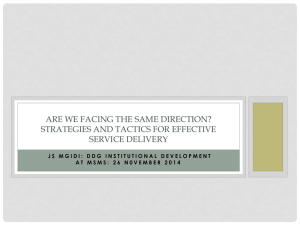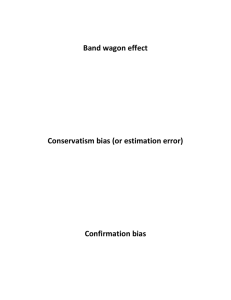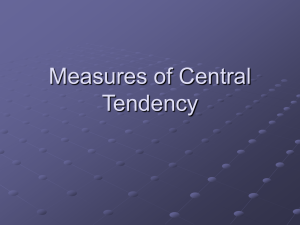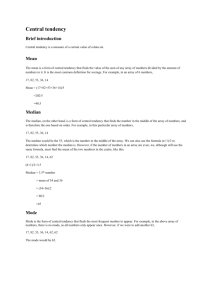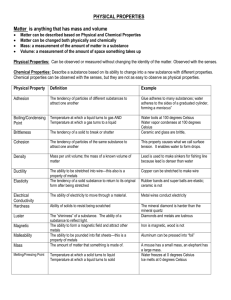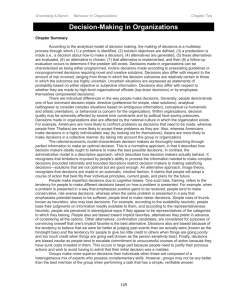Chapter 10 – Decision making in organizations Administrative
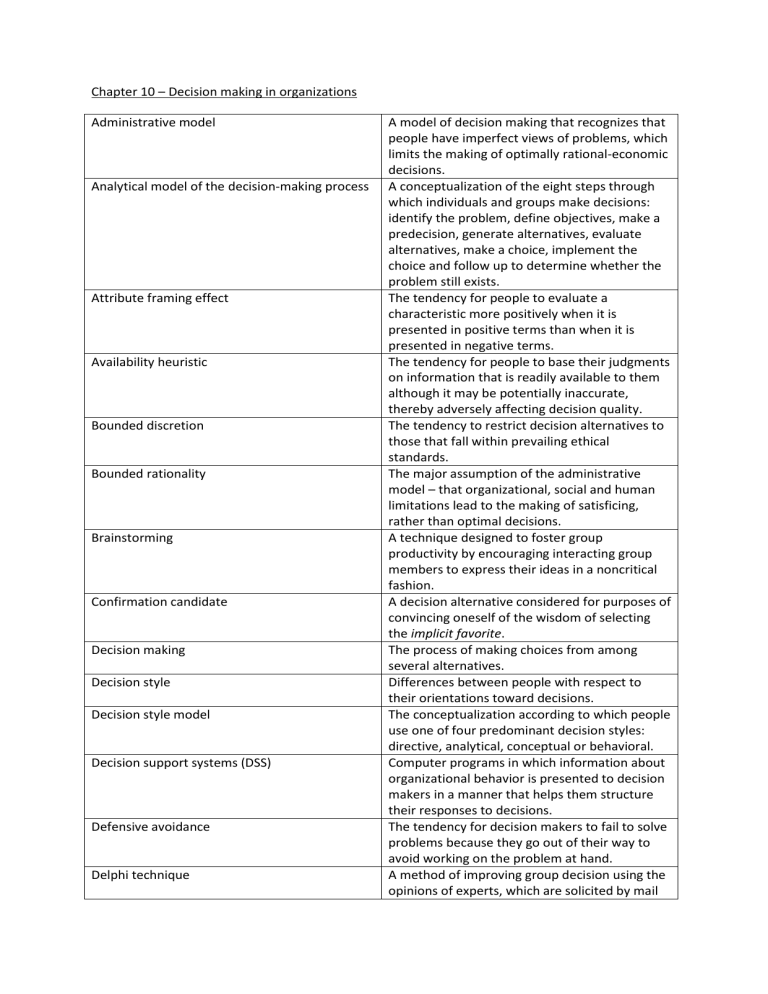
Chapter 10 – Decision making in organizations
Administrative model
Analytical model of the decision-making process
Attribute framing effect
Availability heuristic
Bounded discretion
Bounded rationality
Brainstorming
Confirmation candidate
Decision making
Decision style
Decision style model
Decision support systems (DSS)
Defensive avoidance
Delphi technique
A model of decision making that recognizes that people have imperfect views of problems, which limits the making of optimally rational-economic decisions.
A conceptualization of the eight steps through which individuals and groups make decisions: identify the problem, define objectives, make a predecision, generate alternatives, evaluate alternatives, make a choice, implement the choice and follow up to determine whether the problem still exists.
The tendency for people to evaluate a characteristic more positively when it is presented in positive terms than when it is presented in negative terms.
The tendency for people to base their judgments on information that is readily available to them although it may be potentially inaccurate, thereby adversely affecting decision quality.
The tendency to restrict decision alternatives to those that fall within prevailing ethical standards.
The major assumption of the administrative model – that organizational, social and human limitations lead to the making of satisficing, rather than optimal decisions.
A technique designed to foster group productivity by encouraging interacting group members to express their ideas in a noncritical fashion.
A decision alternative considered for purposes of convincing oneself of the wisdom of selecting the implicit favorite.
The process of making choices from among several alternatives.
Differences between people with respect to their orientations toward decisions.
The conceptualization according to which people use one of four predominant decision styles: directive, analytical, conceptual or behavioral.
Computer programs in which information about organizational behavior is presented to decision makers in a manner that helps them structure their responses to decisions.
The tendency for decision makers to fail to solve problems because they go out of their way to avoid working on the problem at hand.
A method of improving group decision using the opinions of experts, which are solicited by mail
Empowered decision making
Escalation of commitment phenomenon
Framing
Goal framing effect
Group decision support systems (GDSS)
Groupthink
Heuristics hindsight bias
Hypervigilance
Image theory
Implicit favorite
Indecisiveness
Nominal group technique (NGT) and then compiled. The expert consensus of opinions is used to make a decision.
The practice of vesting power for making decisions in the hands of employees themselves.
The tendency for individuals to continue to support previously unsuccessful courses of action.
The tendency for people to make different decisions based on how the problem is presented to them.
The tendency for people to be more strongly persuaded by information that is framed in negative terms than information that is framed in positive terms.
Interactive computer-based systems that combine communication, computer and decision technologies to improve the effectiveness of group problem-solving meetings.
The tendency for members of highly cohesive groups to so strongly conform to group pressures regarding a certain decision that they fail to think critically, rejecting the potentially correcting influences of outsiders.
Simple decision rules (rules of thumb)used to make quick decisions about complex problems.
(see availability heuristic and representativeness heuristic).
The tendency for people to perceive outcomes as more inevitable after they have occurred (i.e. in hindsight) than before they occurred (i.e. in foresight).
The state in which an individual frantically searches for quick solutions to problems, and goes from one idea to another out of a sense of desperations that one idea isn’t working and that another needs to be considered before time runs out.
A theory of decision making that recognizes that decisions are made in an automatic, intuitive fashion. According to the theory, people will adopt a course of action that best fits their individual principles, current goals and plans for the future.
One’s preferred decision alternative, selected even before all options have been considered.
An individual difference variable reflecting the degree to which people approach decisions eagerly as opposed to wanting to put them off.
A technique for improving group decisions in which small groups of individuals systematically present and discuss their ideas before privately
Nonprogrammed decisions
Person sensitivity bias
Predecision
Programmed decisions
Rational decisions
Rational-economic model
Representativeness heuristic
Risky choice framing effect
Satisficing decisions
Stepladder technique
Strategic decisions
Top-down decision making
Unconflicted adherence
Unconflicted change voting on their preferred solution. The most preferred solution is accepted as the group’s decision.
Decisions made about a highly novel problem for which there is no pre-specified course of action.
The tendency for people to give too little credit to others when things are going poorly and too much credit when things are going well.
A decision about what process to follow in making a decision.
Highly routine decisions made according to preestablished organizational routines and procedures.
Decisions that maximize the chance of attaining an individual’s, group’s or organization’s goals.
The model of decision making according to which decision makers consider all possible alternatives to problems before selecting the optimal solution.
The tendency to perceive others in stereotypical ways if they appear to be typical representatives of the category to which they belong.
The tendency for people to avoid risks when situations are presented in a way that emphasizes positive gains, and to take risks when situations are presented in a way that emphasizes potential losses that may be suffered.
Decisions made by selecting the first minimally acceptable alternative as it becomes available.
A technique for improving the quality of group decisions that minimizes the tendency for group members to be unwilling to present their ideas by adding new members to a group one at a time and requiring each to present his or her ideas independently to a group that already has discussed the problem at hand.
Nonprogrammed decisions typically made by high-level executives regarding the direction their organization should take to achieve its mission.
The practice of vesting decision-making power in the hands of superiors as opposed to lower-level employees.
The tendency for decision makers to stick to the first idea that comes to their minds without more deeply evaluating the consequences.
The tendency for people to quickly change their minds and to adopt the first new idea to come along.

